25 OCTOBER – 02 NOVEMBER 2023
By Chris Lotz
Overview
This was a shorter version of our usual Iguazú and Pantanal trip which usually also includes the Cerrado (but not this time). The main aim of this shortened trip was to see arguably the world’s most spectacular waterfall (Iguazú), Jaguar and other iconic mammals of South America, but we also saw a plethora of avian specials including some trickier ones like Zigzag Heron.

One of the five Jaguar we saw on this trip.
Some of the many highlights of this trip were five Jaguar (two close-up pairs during boat trips and one at night from the lodge), three Giant (River) Otter, good views of a Giant Anteater, playful Lowland (Brazilian) Tapir, the planet’s largest parrot, Hyacinth Macaw and five parakeet species, a day-roosting Great Potoo with its baby, eleven hummingbird species, many of them close-up at a hummingbird garden, Sungrebe, Sunbittern, a great many waterbirds including some charismatic ones like Boat-billed Heron (mini shoebill!), some close-up owls, all five kingfisher species, numerous woodpeckers, Toco Toucan, Red-legged Seriema, close-up Bat Falcon, confiding Sharp-tailed Streamcreeper, Plush-crested Jay, luminously dazzling Orange-backed Troupial, numerous spectacular tanagers, and lots more.
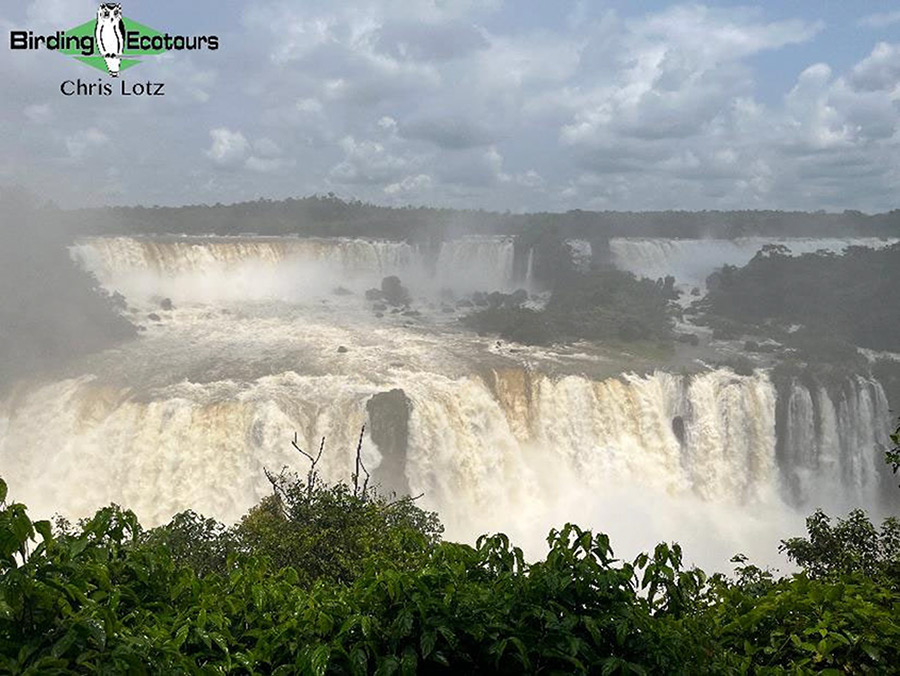
One part of the magnificent Iguazú Falls! It’s vast, with stacks of different views!
Detailed Report
Day 1, 25th October 2023. Arrival in Foz do Iguazú and transfer to the Argentina side of Iguazu Falls
We met at Foz do Iguazú airport in the Brazilian state of Paraná, crossed the border into Argentina and drove to our lovely hotel (Selva de Laurel) in the forest for the next three nights. Katie saw a Swallow-tailed Kite and we all saw Planalto and Olivaceous Woodcreepers before freshening up for dinner after our overnight flights.
Day 2, 26th October 2023. Birding Urugua-í Park and the Hummingbird Garden
After breakfast, we headed to Urugua-í Park where we found some star birds. Some of the birding highlights here included great views of Sharp-tailed Streamcreeper, Ochre-faced Tody-Tyrant, Ochre-collared Piculet (a diminutive woodpecker) and its massive cousin, Lineated Woodpecker, at the other end of the size spectrum. A gorgeous Blue Manakin also showed close-up and the much duller Greenish Schiffornis cooperated well. Chivi Vireo, Tropical Parula, White-rimmed Warbler and Golden-crowned Warbler were everywhere. Other birds that were around included Greater Ani, Smooth-billed Ani, Rufescent Tiger Heron, Plumbeous Kite, several beautiful Surucua Trogon, Buff-browed Foliage-gleaner, Red-rumped Cacique, Creamy-bellied Gnatcatcher, White-shouldered Fire-eye and Rufous-capped Spinetail. Red-crowned Ant Tanager, beautiful Swallow Tanager, Black-goggled Tanager, Ruby-crowned Tanager and Green-winged Saltator also put in appearances.
Flycatchers were everywhere, including a lot of the spectacular Fork-tailed Flycatcher, Cattle Tyrant, Great Kiskadee, Social Flycatcher, Piratic Flycatcher and Tropical Kingbird.
We stopped at our site for Araucaria Tit-Spinetail and were not disappointed. We also saw various other birds here, including Monk Parakeet adding sticks to an already huge, messy nest.
In the afternoon, we enjoyed close up views of many bird species in the Hummingbird Garden, “Jardin de los Picaflores”. The hummers were Black Jacobin, Planalto Hermit, Black-throated Mango, Glittering-bellied Emerald, Versicolored Emerald, Gilded Sapphire, Violet-capped Woodnymph and the spectacular Swallow-tailed Hummingbird. It was not only hummingbirds that entertained us here; we also saw a close-up Yellow-fronted Woodpecker, numerous Bananaquit, Sayaca Tanager and brightly-plumaged Purple-throated and Violaceous Euphonias.
Mammal species that we enjoyed today were Azara’s Agouti and a Crab-eating Fox along the road.
Day 3, 27th October 2023. Enjoying Iguazú Falls (Argentinian side)
Today we enjoyed spectacular views from three of the trails at the falls. We were very lucky that the trail to Devil’s Throat, which had been closed for a while, re-opened this morning. Waiting for the park tram to take us there, we admired some great birds. There were stacks of Fork-tailed Flycatcher (more than I’ve ever seen elsewhere), a number of beautiful Plush-crested Jay, attractive Southern Lapwing, a Green Ibis, entertaining Chalk-browed Mockingbird and several pretty Saffron Finch.
On the trails, Great Dusky Swift were amazing to watch as they flew close to us and under the waterfall (!) to their nesting places. Sick’s Swift and many Grey-breasted Martin were also around. The lower trail provided spectacular vistas of the falls, and a few additional birds like Black-crowned Night Heron, Ringed Kingfisher, White-eyed Parakeet, Double-collared Seedeater and other species were also around.
Mammal-wise, cute and attractively-marked South American Coati made nuisances of themselves, and Katie saw a Collared Peccary.
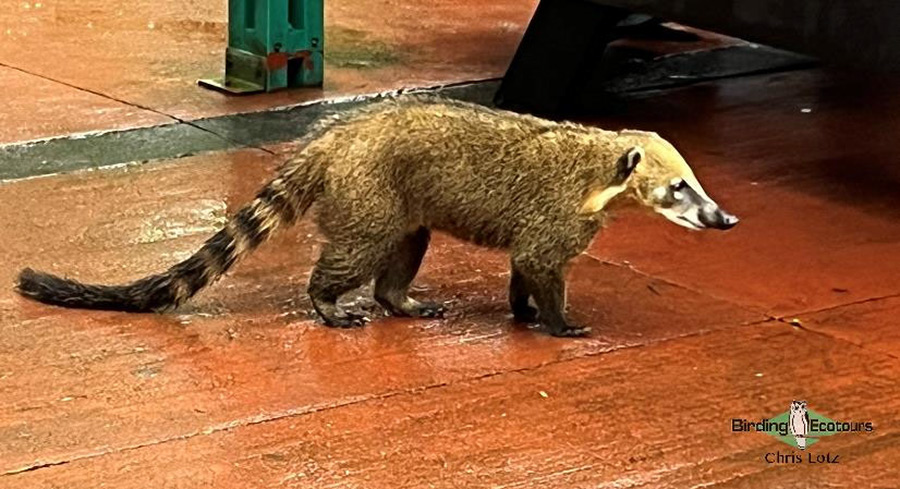
A naughty South American Coati
In the mid-afternoon, we did a walk from our hotel. This was productive, as we found a cooperative Dark-billed Cuckoo, some Thrush-like Wren, our first of many Wattled Jacana, Striated Heron, Boat-billed Flycatcher and many other flycatcher species we’d already seen. Black-crowned Tityra, Saffron-billed Sparrow and a pair of spectacular and unusual Magpie Tanager were also around.

Part of the vast Iguazú Falls from one of the higher trails.
Day 4, 28th October 2023. Travel day
Today we crossed the border into Brazil again and went to the airport to fly to Cuiabá via São Paulo. Unfortunately, due to heavy rain, our flight to São Paulo was delayed and we missed our connection to Cuiabá so we had to spend the night at an airport hotel. That meant we started the birding the next day a few hours late but it was by no means the end of the world.
Day 5, 29th October 2023. Flight to Cuiabá and transfer to Porte Jofre, birding along the way!
Today was a very exciting day as we flew to Cuiabá, the gateway to the planet’s largest wetland, the Pantanal! The Pantanal is one of the world’s great wildlife paradises, and is particularly productive as a mammal and bird watching destination at the end of the dry season when the wildlife is concentrated around the lagoons, rivers and oxbow lakes. This part of the Pantanal must also be the best place on the planet to observe Jaguar, and this trip did not disappoint as we saw two pairs of these huge, beautiful cats close-up along the river bank at Porte Jofre over the next couple of days, followed by a sighting of one at night next to our lodgings at Piuval at the end of the tour! Not only did we see Jaguar, but we also enjoyed other incredible mammals, and morning boat trips at Porte Jofre generated around 100 birds per session – we counted an average of a bird a minute (60 birds per hour) a couple of times.
We had about a five-hour drive to get to Port Jofre along the famous Transpantaneira, a road that allows easy access to a chunk of the Pantanal. During this exciting drive, we found a lot of new birds for the trip. These included Greater Rhea, a Tataupa Tinamou that ran across the road in front of us (incredible luck!), the odd-looking Southern Screamer, lots of noisy Chaco Chachalaca, the Brazilian endemic Chestnut-bellied Guan, our first of many Guira Cuckoo and Smooth-billed Ani (and we were also to see tons of Greater Ani along the river over the next three days), Grey-cowled Wood-rail, Limpkin, elegant Black Skimmer, Wood Stork, Jabiru, four species of ibis, nine species of heron, beautiful Black-collared Hawk, Great Black Hawk, Roadside Hawk and our first Kingfisher species, Ringed. (By the end of the trip we’d seen all five of the region’s kingfishers.) Other birds along this drive were Toco Toucan, close-up Yellow-chinned Spinetail, Purplish Jay, Giant Cowbird, Shiny Cowbird, Greyish Baywing and Unicolored Blackbird (The species is unfortunately named after the male, the female is more colorful and multi-colored!)
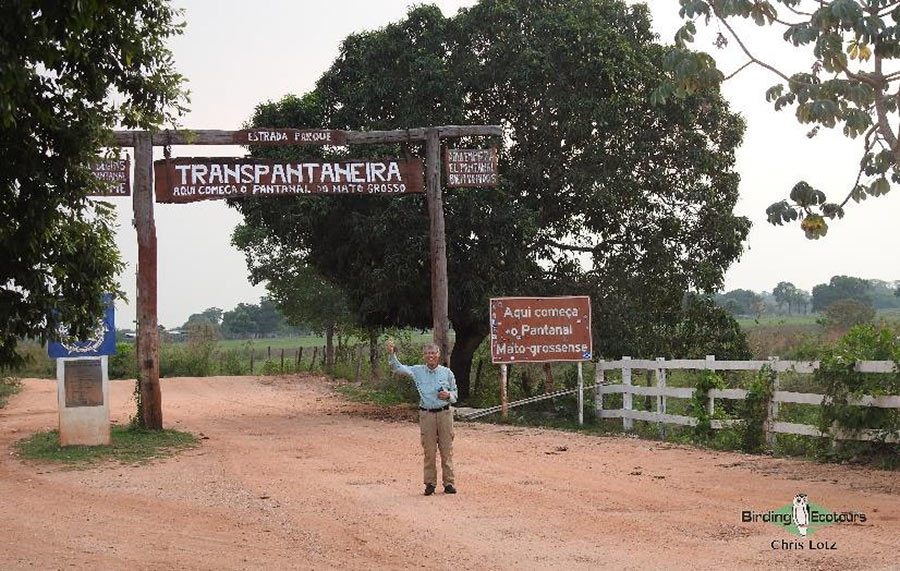
Bill at the start of the Transpantaneira Road.
The mournful call of White-tipped Dove would be a major part of the rather varied background soundtrack of the Pantanal section of our tour.
Leaving some of the best birds of the day for last, we found an adult and baby Great Potoo at its daytime roost (see the photo below), and our first teaser of a pair of Hyacinth Macaw, the world’s largest parrot.
We also made a very good start to our mammal list today, with a lot of Capybara (the world’s largest rodent), its cuter relative Azara’s Agouti, a much wilder-seeming South American Coati than the habituated ones around Iguaza Falls we’d seen before, and Black-and-gold Howler Monkey.
Reptile-wise we also made a good start, with Gold Tegu and a lot of Yacare Caiman.
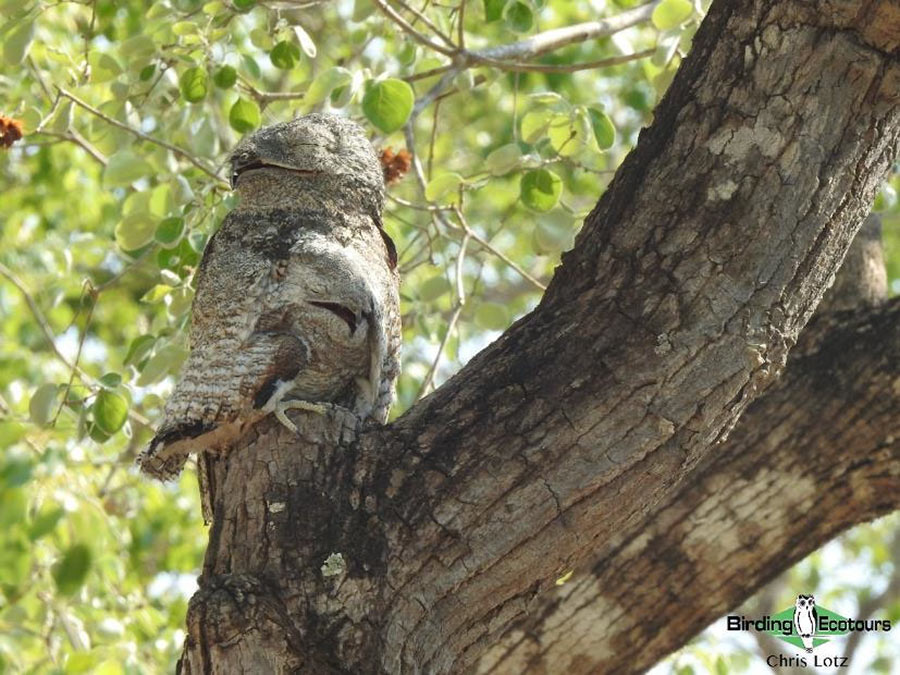
Great Potoo adult and chick.
Day 6, 30th October 2023. Morning and afternoon boat trip along the Cuiabá River
Jaguar was our main target today and we were not disappointed, finding our first pair of these spectacular cats very close to us on the river bank. They cooperated wonderfully, putting on a real show, interacting with each other and at one point walking in the shallow water pretty near us! We enjoyed saturation views of these beautiful animals – our biggest target – taking the pressure off us, so we could look for other wildlife.
The only other new mammal for the trip today (apart from Jaguar) was Azara’s Capuchin. Reptile-wise, we found our first of several Green Iguana,and Common House Gecko was around the rooms.
Today, on the morning and afternoon boat trips, we added numerous trips birds such as White-winged Swallow, Brown-chested Martin (very large numbers of these hirundines), attractive Black-capped Donacobius, Brazilian Teal, wonderfully-marked Bare-faced Currasow, Blue-throated Piping Guan, a couple of hummingbirds in the form of Buff-bellied Hermit and Gilded Sapphire, Pale-vented Pigeon, Scaled Dove, Picui Ground Dove, exquisite Pied Plover, Lesser Yellow-headed Vulture (we had already seen plenty of Black and Turkey Vultures on previous days), Western Osprey, Savanna Hawk, White-tailed Hawk, three kingfisher species, Pale-legged Hornero among the more common Rufous Hornero and many others. Crested Oropendola, Solitary Cacique, Yellow-rumped Cacique, Variable Oriole, Bluish-grey Saltator, Rusty-backed Spinetail and White-lored Spinetail put in appearances, as did a Grey-crested Cacholote, a Black-backed Water Tyrant and many Rusty-margined Flycatcher.A Ferruginous Pygmy Owl had a mob of other birds around it such as White-wedged Piculet, Forest Elaenia, Common Tody Flycatcher, Southern Beardless Tyrannulet, Fuscous Flycatcher, Masked Gnatcatcher, Chestnut-vented Conebill, Black-fronted Nunbird and others. These tiny owls can certainly be very useful when they get mobbed by all kinds of other species!
A mixed flock of seed-eating birds along the riverside contained Double-collared Seedeater, Lined Seedeater, Rusty-collared Seedeater and White-bellied Seedeater. Colorful Yellow-billed Cardinal was abundant everywhere, and small flocks of Silver-beaked Tanager also entertained us from time to time.
During the heat of the day, we took three hours off for lunch and a rest, enjoying some gorgeous birds around the accommodations. These included Turquoise-fronted Amazon, Parakeets in the form of White-eyed, Peach-fronted, Yellow-chevroned and Monk, and sometimes Hyacinth Macaws. Dazzling Orange-backed Troupial was one of the most beautiful birds around and we got great views many times. White Woodpecker and the duller Golden-green Woodpecker were delights to see around the lodgings. Rufous-fronted Thornbird and various flycatchers such as Streaked Flycatcher were all around. We also saw a couple of pairs of Black-tailed Tityra.
We then did an afternoon boat trip. On our way back to the accommodation, we were delighted to see our first Sungrebe for the trip, along with lots of other birds and good mammals.
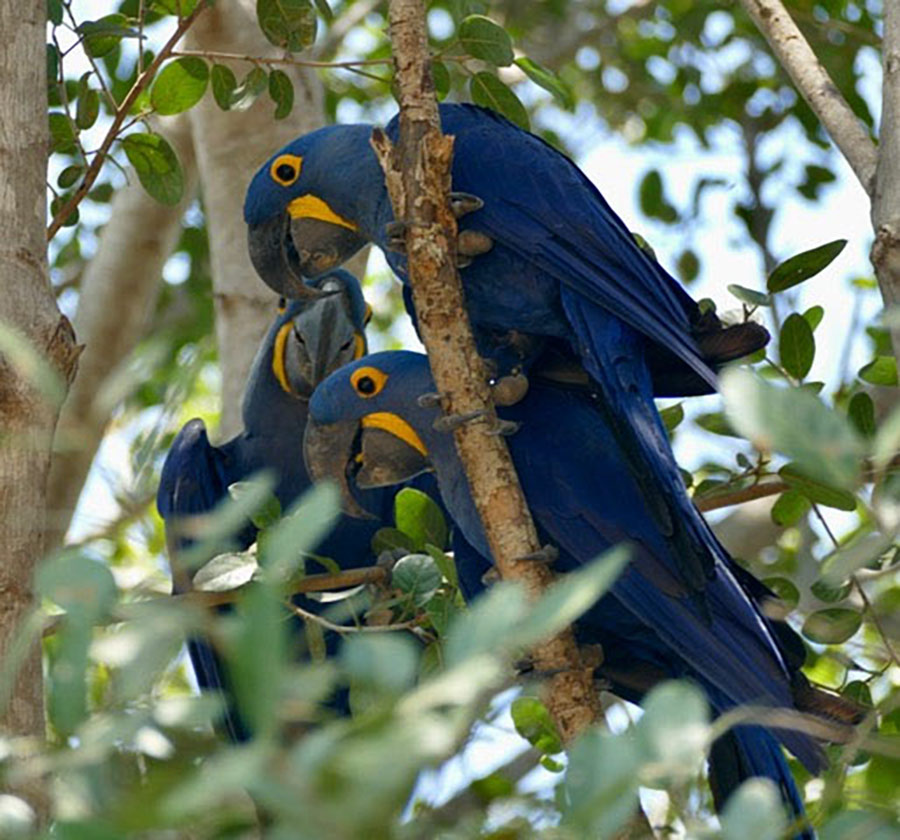
Hyacinth Macaw, an iconic bird of the Pantanal (photo from our 2022 tour, by Eric Schroeder).
Day 7, 31st October 2023. More boat trips on the Cuiabá River
Today followed a similar pattern to yesterday, with boat trips in the morning and afternoon, and about three hours back at the accommodation over lunch during the hottest part of the day.
We found a second pair of Jaguar today. These also “did” a lot (like yesterday’s ones) rather than simply lying asleep. At one point, they stared at an Olive Whip Snake near them. Other mammal species were out of this world as well. We followed three Giant (River) Otter as they swam along the side of the river. Two of them caught fish and noisily ate them right next to us. Later, we had the most wonderful experience with two Lowland (Brazilian) Tapir playing and running around in the water! A couple of very odd, cute Brazilian Cavi foraged along riverside beaches.
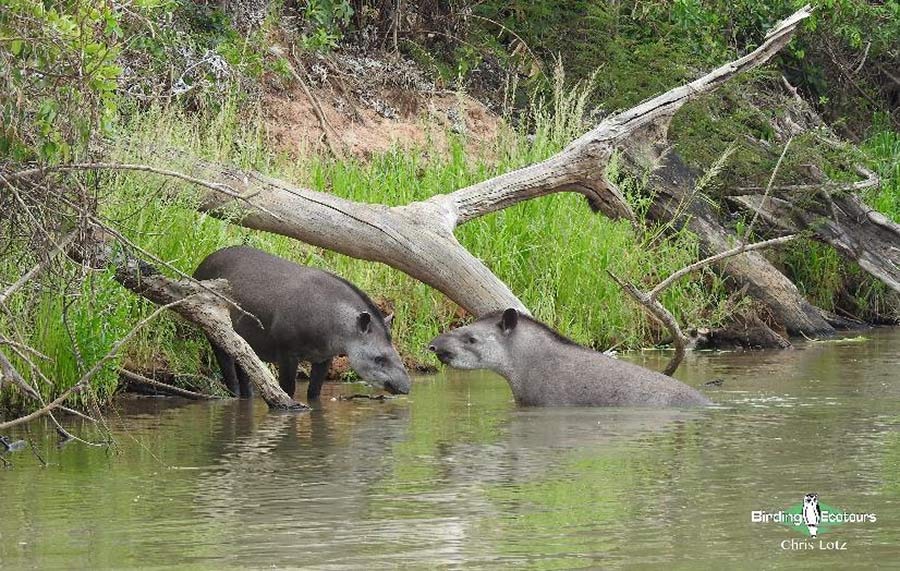
Playful Lowland Tapir
The morning and afternoon boat trips were again great not only for mammals, but also for birds. We found some excellent new additions to the trip list, like White-throated Piping Guan, Fork-tailed Woodnymph, Glittering-throated Emerald, Little Cuckoo, a close-up Pantanal Snipe on a beach, Vermilion Flycatcher, Rufous-tailed Jacamar, close-up Bat Falcon, Large-billed Antwren, Mato Grosso Antbird and others.
During the heat of the day, after lunch, we set up the scope to look at the birds around the oxbow lake next to our lodgings. This was productive, as there were many shorebirds and waterbirds. These included White-faced Whistling Duck, Spotted Sandpiper, Greater Yellowlegs, Lesser Yellowlegs, Collared Plover, Pied Plover, Southern Lapwing, Yellow-billed Tern, sleek Black Skimmer, three different ibis species, eight heron species, Yellowish Pipit and other species.
As we returned to the accommodation at the end of the afternoon boat trip at dusk, we counted at least 20 Band-tailed Nighthawk hunting low over the oxbow lake.
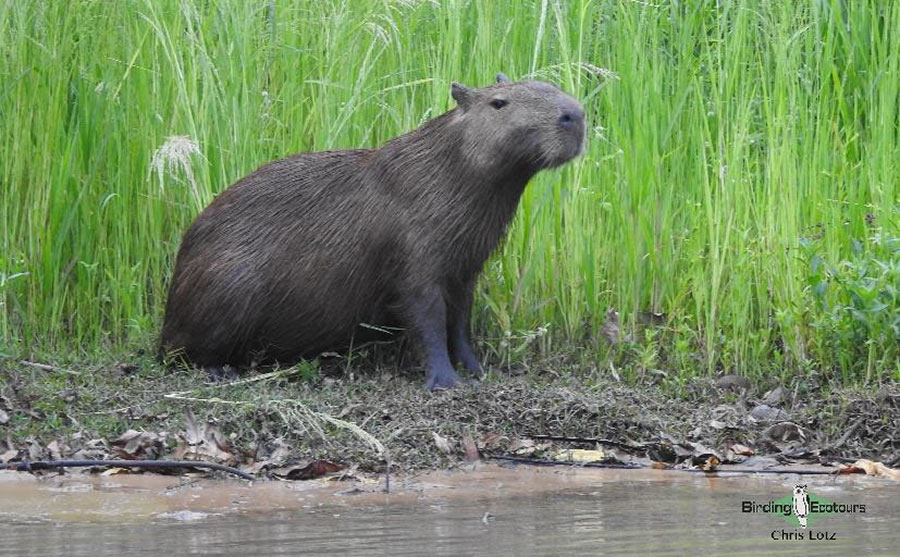
Capybara.
Day 8, 1st November 2023. Transfer to Piuval Lodge with birding stops and a boat trip en route
This was another exceptionally rewarding and rather varied day. After breakfast, we did a short walk near the lodge and added a few more birds to our growing trip list. These included Pale-crested Woodpecker and White-eyed Attila (we’d previously only heard this species). Our second Boat-billed Flycatcher was also a good sighting.
We then headed back along the Transpantaneira and had lunch at the Mato Grosso Hotel. After lunch, we did a spectacular boat trip from this hotel. We almost aborted the boat trip early because we got caught by surprise in a sudden heavy downpour, but luckily the rain did not last long and actually just cooled it off nicely! Our rewards for not stopping because of a little rain, were large. The highlight was close views of a vocal Zigzag Heron, a tiny, enigmatic, often elusive species. We also saw Boat-billed Heron and a number of other heron species. We got very close-up views of a Sungrebe out of the water, showing its dazzlingly-patterned feet closely.
On the way to Piuval Lodge, we saw stacks of waterbirds, raptors and other goodies. We also stopped to look at Burrowing Owl, White-browed Blackbird with its brilliant red front, Muscovy Duck, an amazing Sunbittern both in flight (particularly spectacular) and, later, perched.
As we turned into the grounds of Piuval lodge, we enjoyed seeing a Red-legged Seriema and a pair of Great Rufous Woodcreeper, both stunning new trip bird species.
After dinner, we saw a Jaguar right next to the lodge, our fifth one! We then did a night drive and saw several of the nocturnal Boat-billed Heron close-up, many Pauraque, a distant Common Potoo, Crab-eating Fox and other wildlife.
Reptile-wise, we added Aneiva Lizard and Collared Tropieurus today.
Day 9, 2nd November 2023. Final game and birding drive before heading back to Cuiabá
The trip ended on a high note with Giant Anteater, fabulous views of Hyacinth Macaw and various other species, before we drove back to Cuiabá for our flights.
Please find an eBird trip report at Brazil/Argentina 2023 – Iguaza and Pantanal – eBird Trip Report and the eBird report’s map below (please note that some leader-only heard birds are excluded from the tour list below).
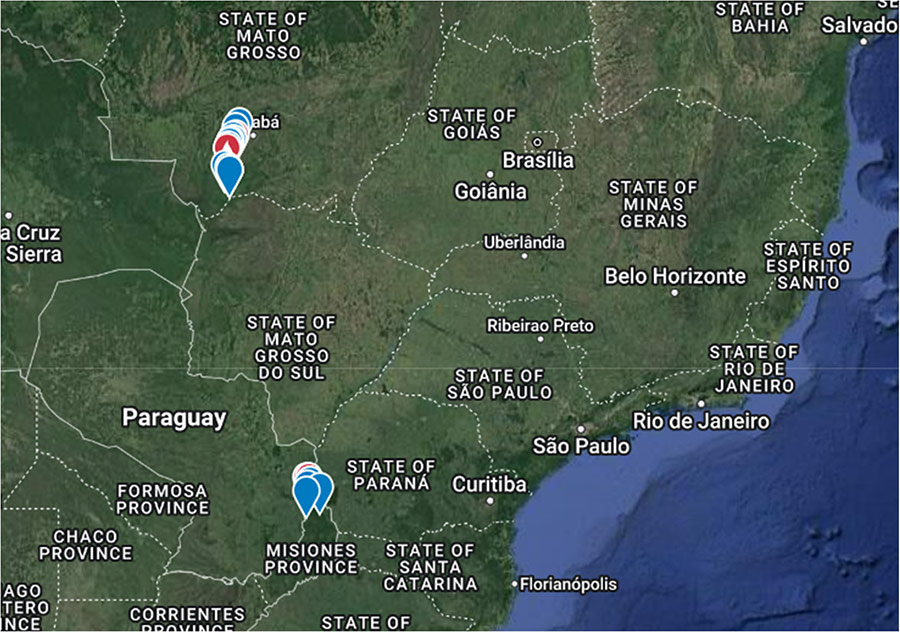
EBird map
Bird List – Following IOC (13.2)
Birds ‘heard only’ are marked with (H) after the common name, all other species were seen.
The following notation after species names is used to show conservation status following BirdLife International: VU = Vulnerable.
| Common name | Scientific name |
| Rheas (Rheidae) | |
| Greater Rhea | Rhea americana |
| Tinamous (Tinamidae) | |
| Undulated Tinamou (H) | Crypturellus undulatus |
| Tataupa Tinamou | Crypturellus tataupa |
| Screamers (Anhimidae) | |
| Southern Screamer | Chauna torquate |
| Ducks, Geese, Swans (Anatidae) | |
| White-faced Whistling Duck | Dendrocygna viduata |
| Muscovy Duck | Cairina moschata |
| Brazilian Teal | Amazonetta brasiliensis |
| Chachalacas, Curassows, Guans (Cracidae) | |
| Chaco Chachalaca | Ortalis canicollis |
| Chestnut-bellied Guan – VU | Penelope ochrogaster |
| Blue-throated Piping Guan | Pipile cumanensis |
| White-throated Piping Guan | Pipile grayi |
| Red-throated Piping Guan – VU | Pipile cujubi |
| Bare-faced Curassow – VU | Crax fasciolata |
| Nightjars (Caprimulgidae) | |
| Band-tailed Nighthawk | Nyctiprogne leucopyga |
| Pauraque | Nyctidromus albicollis |
| Potoos (Nyctibiidae) | |
| Great Potoo | Nyctibius grandis |
| Common Potoo | Nyctibius griseus |
| Swifts (Apodidae) | |
| Great Dusky Swift | Cypseloides senex |
| Grey-rumped Swift | Chaetura cinereiventris |
| Sick’s Swift | Chaetura meridionalis |
| Hummingbirds (Trochilidae) | |
| Black Jacobin | Florisuga fusca |
| Buff-bellied Hermit | Phaethornis subochraceus |
| Planalto Hermit | Phaethornis pretrei |
| Black-throated Mango | Anthracothorax nigricollis |
| Glittering-bellied Emerald | Chlorostilbon lucidus |
| Fork-tailed Woodnymph | Thalurania furcata |
| Violet-capped Woodnymph | Thalurania glaucopis |
| Swallow-tailed Hummingbird | Eupetomena macroura |
| Versicolored Emerald | Chrysuronia versicolor |
| Glittering-throated Emerald | Chionomesa fimbriata |
| Gilded Sapphire | Hylocharis chrysura |
| Cuckoos (Cuculidae) | |
| Guira Cuckoo | Guira guira |
| Greater Ani | Crotophaga major |
| Smooth-billed Ani | Crotophaga ani |
| Little Cuckoo | Coccycua minuta |
| Squirrel Cuckoo | Piaya cayana |
| Dark-billed Cuckoo | Coccyzus melacoryphus |
| Pigeons, Doves (Columbidae) | |
| Rock Dove | Columba livia |
| Picazuro Pigeon | Patagioenas picazuro |
| Pale-vented Pigeon | Patagioenas cayennensis |
| Scaled Dove | Columbina squammata |
| Ruddy Ground Dove | Columbina talpacoti |
| Picui Ground Dove | Columbina picui |
| White-tipped Dove | Leptotila verreauxi |
| Grey-fronted Dove | Leptotila rufaxilla |
| Eared Dove | Zenaida auriculata |
| Finfoots (Heliornithidae) | |
| Sungrebe | Heliornis fulica |
| Rails, Crakes & Coots (Rallidae) | |
| Grey-cowled Wood Rail | Aramides cajaneus |
| Limpkin (Aramidae) | |
| Limpkin | Aramus guarauna |
| Stilts, Avocets (Recurvirostridae) | |
| White-backed Stilt | Himantopus melanurus |
| Plovers (Charadriidae) | |
| Southern Lapwing | Vanellus chilensis |
| Collared Plover | Charadrius collaris |
| Pied Plover | Hoploxypterus cayanus |
| Jacanas (Jacanidae) | |
| Wattled Jacana | Jacana jacana |
| Sandpipers, Snipes (Scolopacidae) | |
| White-rumped Sandpiper | Calidris fuscicollis |
| Pectoral Sandpiper | Calidris melanotos |
| Pantanal Snipe | Gallinago paraguaiae |
| Spotted Sandpiper | Actitis macularius |
| Solitary Sandpiper | Tringa solitaria |
| Lesser Yellowlegs | Tringa flavipes |
| Greater Yellowlegs | Tringa melanoleuca |
| Gulls, Terns, Skimmers (Laridae) | |
| Black Skimmer | Rynchops niger |
| Large-billed Tern | Phaetusa simplex |
| Sunbittern (Eurypygidae) | |
| Sunbittern | Eurypyga helias |
| Storks (Ciconiidae) | |
| Wood Stork | Mycteria americana |
| Jabiru | Jabiru mycteria |
| Anhingas, Darters (Anhingidae) | |
| Anhinga | Anhinga anhinga |
| Cormorants, Shags (Phalacrocoracidae) | |
| Neotropic Cormorant | Nannopterum brasilianum |
| Ibises, Spoonbills (Threskiornithidae) | |
| Plumbeous Ibis | Theristicus caerulescens |
| Buff-necked Ibis | Theristicus caudatus |
| Green Ibis | Mesembrinibis cayennensis |
| Bare-faced Ibis | Phimosus infuscatus |
| Herons, Bitterns (Ardeidae) | |
| Rufescent Tiger Heron | Tigrisoma lineatum |
| Agami Heron – VU | Agamia agami |
| Boat-billed Heron | Cochlearius cochlearius |
| Night-heron | Nycticorax nycticorax |
| Striated Heron | Butorides striata |
| Cattle Egret | Bubulcus ibis |
| Cocoi Heron | Ardea cocoi |
| Great White Egret | Ardea alba |
| Capped Heron | Pilherodius pileatus |
| Whistling Heron | Syrigma sibilatrix |
| Little Blue Heron | Egretta caerulea |
| Snowy Egret | Egretta thula |
| New World Vultures (Cathartidae) | |
| Black Vulture | Coragyps atratus |
| Turkey Vulture | Cathartes aura |
| Lesser Yellow-headed Vulture | Cathartes burrovianus |
| Ospreys (Pandionidae) | |
| Osprey | Pandion haliaetus |
| Kites, Hawks, Eagles (Accipitridae) | |
| Swallow-tailed Kite | Elanoides forficatus |
| Plumbeous Kite | Ictinia plumbea |
| Black-collared Hawk | Busarellus nigricollis |
| Savanna Hawk | Buteogallus meridionalis |
| Great Black Hawk | Buteogallus urubitinga |
| Roadside Hawk | Rupornis magnirostris |
| White-tailed Hawk | Geranoaetus albicaudatus |
| Owls (Strigidae) | |
| Burrowing Owl | Athene cunicularia |
| Ferruginous Pygmy Owl | Glaucidium brasilianum |
| Trogons (Trogonidae) | |
| Blue-crowned Trogon | Trogon curucui |
| Surucua Trogon | Trogon surrucura |
| Kingfishers (Alcedinidae) | |
| Amazon Kingfisher | Chloroceryle amazona |
| American Pygmy Kingfisher | Chloroceryle aenea |
| Green Kingfisher | Chloroceryle americana |
| Green-and-rufous Kingfisher | Chloroceryle inda |
| Ringed Kingfisher | Megaceryle torquata |
| Motmots (Momotidae) | |
| Amazonian Motmot (H) | Momotus momota |
| Jacamars (Galbulidae) | |
| Rufous-tailed Jacamar | Galbula ruficauda |
| Puffbirds (Bucconidae) | |
| Black-fronted Nunbird | Monasa nigrifrons |
| Toucans (Ramphastidae) | |
| Channel-billed Toucan | Ramphastos vitellinus |
| Woodpeckers (Picidae) | |
| Ochre-collared Piculet | Picumnus temminckii |
| White-wedged Piculet | Picumnus albosquamatus |
| White Woodpecker | Melanerpes candidus |
| Yellow-fronted Woodpecker | Melanerpes flavifrons |
| Little Woodpecker | Veniliornis passerinus |
| Golden-green Woodpecker | Piculus chrysochloros |
| Campo Flicker | Colaptes campestris |
| Pale-crested Woodpecker | Celeus lugubris |
| Blond-crested Woodpecker (H) | Celeus flavescens |
| Lineated Woodpecker | Dryocopus lineatus |
| Seriemas (Cariamidae) | |
| Red-legged Seriema | Cariama cristata |
| Caracaras, Falcons (Falconidae) | |
| Crested Caracara | Caracara plancus |
| Yellow-headed Caracara | Milvago chimachima |
| Bat Falcon | Falco rufigularis |
| African & New World Parrots (Psittacidae) | |
| Monk Parakeet | Myiopsitta monachus |
| Yellow-chevroned Parakeet | Brotogeris chiriri |
| Turquoise-fronted Amazon | Amazona aestiva |
| Hyacinth Macaw – VU | Anodorhynchus hyacinthinus |
| Peach-fronted Parakeet | Eupsittula aurea |
| White-eyed Parakeet | Psittacara leucophthalmus |
| Ovenbirds (Furnariidae) | |
| Olivaceous Woodcreeper | Sittasomus griseicapillus |
| Planalto Woodcreeper | Dendrocolaptes platyrostris |
| Great Rufous Woodcreeper | Xiphocolaptes major |
| Pale-legged Hornero | Furnarius leucopus |
| Rufous Hornero | Furnarius rufus |
| Sharp-tailed Streamcreeper | Lochmias nematura |
| Black-capped Foliage-gleaner | Philydor atricapillus |
| Buff-browed Foliage-gleaner | Syndactyla rufosuperciliata |
| Araucaria Tit-Spinetail | Leptasthenura setaria |
| Rufous-fronted Thornbird | Phacellodomus rufifrons |
| Rusty-backed Spinetail | Cranioleuca vulpina |
| Grey-crested Cacholote | Pseudoseisura unirufa |
| Yellow-chinned Spinetail | Certhiaxis cinnamomeus |
| White-lored Spinetail | Synallaxis albilora |
| Rufous-capped Spinetail | Synallaxis ruficapilla |
| Antbirds (Thamnophilidae) | |
| Large-billed Antwren | Herpsilochmus longirostris |
| Tufted Antshrike (H) | Mackenziaena severa |
| Bertoni’s Antbird (H) | Drymophila rubricollis |
| Mato Grosso Antbird | Cercomacra melanaria |
| White-shouldered Fire-eye | Pyriglena leucoptera |
| Tyrant Flycatchers, Calyptura (Tyrannidae) | |
| Forest Elaenia | Myiopagis gaimardii |
| Southern Beardless Tyrannulet | Camptostoma obsoletum |
| Yellow Tyrannulet | Capsiempis flaveola |
| Southern Antpipit | Corythopis delalandi |
| Ochre-faced Tody-Flycatcher | Poecilotriccus plumbeiceps |
| Common Tody-Flycatcher | Todirostrum cinereum |
| Fuscous Flycatcher | Cnemotriccus fuscatus |
| Vermilion Flycatcher | Pyrocephalus obscurus |
| Black-backed Water Tyrant | Fluvicola albiventer |
| Cattle Tyrant | Machetornis rixosa |
| Piratic Flycatcher | Legatus leucophaius |
| Rusty-margined Flycatcher | Myiozetetes cayanensis |
| Social Flycatcher | Myiozetetes similis |
| Great Kiskadee | Pitangus sulphuratus |
| Lesser Kiskadee | Philohydor lictor |
| Streaked Flycatcher | Myiodynastes maculatus |
| Boat-billed Flycatcher | Megarynchus pitangua |
| Tropical Kingbird | Tyrannus melancholicus |
| Fork-tailed Flycatcher | Tyrannus savana |
| Short-crested Flycatcher | Myiarchus ferox |
| White-eyed Attila | Attila bolivianus |
| Manakins (Pipridae) | |
| Blue Manakin | Chiroxiphia caudata |
| Tityras, Becards, Sharpbill (Tityridae) | |
| Black-crowned Tityra | Tityra inquisitor |
| Black-tailed Tityra | Tityra cayana |
| Greenish Schiffornis | Schiffornis virescens |
| White-winged Becard (H) | Pachyramphus polychopterus |
| Crested Becard (H) | Pachyramphus validus |
| Vireos, Greenlets, Shrike-babblers (Vireonidae) | |
| Chivi Vireo | Vireo chivi |
| Crows, Jays (Corvidae) | |
| Purplish Jay | Cyanocorax cyanomelas |
| Plush-crested Jay | Cyanocorax chrysops |
| Swallows, Martins (Hirundinidae) | |
| White-winged Swallow | Tachycineta albiventer |
| Blue-and-white Swallow | Pygochelidon cyanoleuca |
| Southern Rough-winged Swallow | Stelgidopteryx ruficollis |
| Brown-chested Martin | Progne tapera |
| Grey-breasted Martin | Progne chalybea |
| Black-capped Donacobius (Donacobiidae) | |
| Black-capped Donacobius | Donacobius atricapilla |
| Wrens (Troglodytidae) | |
| Thrush-like Wren | Campylorhynchus turdinus |
| Buff-breasted Wren (H) | Cantorchilus leucotis |
| House Wren | Troglodytes aedon |
| Gnatcatchers (Polioptilidae) | |
| Creamy-bellied Gnatcatcher | Polioptila lactea |
| Masked Gnatcatcher | Polioptila dumicola |
| Mockingbirds, Thrashers (Mimidae) | |
| Chalk-browed Mockingbird | Mimus saturninus |
| Thrushes (Turdidae) | |
| Creamy-bellied Thrush | Turdus amaurochalinus |
| White-necked Thrush | Turdus albicollis |
| Pale-breasted Thrush | Turdus leucomelas |
| Rufous-bellied Thrush | Turdus rufiventris |
| Old World Sparrows, Snowfinches (Passeridae) | |
| House Sparrow | Passer domesticus |
| Wagtails, Pipits (Motacillidae) | |
| Yellowish Pipit | Anthus chii |
| Finches, Euphonias (Fringillidae) | |
| Purple-throated Euphonia | Euphonia chlorotica |
| Violaceous Euphonia | Euphonia violacea |
| New World Sparrows (Passerellidae) | |
| Saffron-billed Sparrow | Arremon flavirostris |
| Rufous-collared Sparrow | Zonotrichia capensis |
| Oropendolas, New World Orioles, Blackbirds (Icteridae) | |
| White-browed Blackbird | Leistes superciliaris |
| Crested Oropendola | Psarocolius decumanus |
| Solitary Cacique | Cacicus solitarius |
| Yellow-rumped Cacique | Cacicus cela |
| Red-rumped Cacique | Cacicus haemorrhous |
| Orange-backed Troupial | Icterus croconotus |
| Variable Oriole | Icterus pyrrhopterus |
| Giant Cowbird | Molothrus oryzivorus |
| Shiny Cowbird | Molothrus bonariensis |
| Chopi Blackbird | Gnorimopsar chopi |
| Greyish Baywing | Agelaioides badius |
| Unicolored Blackbird | Agelasticus cyanopus |
| New World Warblers (Parulidae) | |
| Tropical Parula | Setophaga pitiayumi |
| White-rimmed Warbler | Myiothlypis leucoblephara |
| Golden-crowned Warbler | Basileuterus culicivorus |
| Cardinals & Allies (Cardinalidae) | |
| Red-crowned Ant Tanager | Habia rubica |
| Tanagers & Allies (Thraupidae) | |
| Hooded Tanager | Nemosia pileate |
| Swallow Tanager | Tersina viridis |
| Green-winged Saltator | Saltator similis |
| Bluish-grey Saltator | Saltator coerulescens |
| Bananaquit | Coereba flaveola |
| Black-goggled Tanager | Trichothraupis melanops |
| Ruby-crowned Tanager | Tachyphonus coronatus |
| Silver-beaked Tanager | Ramphocelus carbo |
| Lined Seedeater | Sporophila lineola |
| Double-collared Seedeater | Sporophila caerulescens |
| Rusty-collared Seedeater | Sporophila collaris |
| White-bellied Seedeater | Sporophila leucoptera |
| Chestnut-vented Conebill | Conirostrum speciosum |
| Saffron Finch | Sicalis flaveola |
| Yellow-billed Cardinal | Paroaria capitata |
| Sayaca Tanager | Thraupis sayaca |
| Total Seen | 224 |
| Total Heard only | 8 |
| Total recorded | 232 |
Mammal List
The following notation after species names is used to show conservation status following the IUCN Red List of Threatened Species: EN = Endangered, VU = Vulnerable, DD = Data Deficient
| Common name | Scientific name |
| Short-nosed Armadillos (Chlamyphoridae) | |
| Yellow Armadillo | Euphractus sexcinctus |
| Anteaters (Myrmecophagidae) | |
| Giant Anteater – VU | Myrmecophaga tridactyla |
| Cavies (Caviidae) | |
| Brazilian Guinea Pig | Cavia aperea |
| Capybara | Hydrochoerus hydrochaeris |
| Rock Cavy (Endemic) | Kerodon rupestris |
| Agoutis and Acouchis (Dasyproctidae) | |
| Azara’s Agouti – DD | Dasyprocta azarae |
| Marmosets and Tamarins (Callitrichidae) | |
| Geoffroy’s Tufted-ear Marmoset (Endemic) | Callithrix geoffroyi |
| Common Marmoset (Endemic) | Callithrix jacchus |
| Wied’s Black-tufted-ear Marmoset (Endemic) – VU | Callithrix kuhlii |
| Cebid Monkeys (Cebidae) | |
| Azaras’s Capuchin | Sapajus cay |
| Spider, Howler, and Woolly Monkeys (Atelidae) | |
| Black-and-gold Howler Monkey | Alouatta caraya |
| Felids (Felidae) | |
| Jaguar | Panthera onca |
| Canids (Canidae) | |
| Crab-eating Fox | Cerdocyon thous |
| Hoary Fox (Endemic) | Lycalopex vetulus |
| Raccoons, Coatis, and Allies (Procyonidae) | |
| South American Coati | Nasua nasua |
| Mustelids (Mustelidae) | |
| Giant Otter – EN | Pteronura brasiliensis |
| Tapirs (Tapiridae) | |
| Lowland Tapir – VU | Tapirus terrestris |
| Peccaries (Tayassuidae) | |
| Collared Peccary | Dicotyles tajacu |
| Deer (Cervidae) | |
| Marsh Deer – VU | Blastocerus dichotomus |
| Red Brocket – DD | Mazama americana |
| Total seen | 20 |
Reptile List
| Common name | Scientific name |
| Alligators and Caimans (Alligatoridae) | |
| Yacare Caiman | Caiman yacare |
| Typical Geckos (Gekkonidae) | |
| Tropical House Gecko | Hemidactylus mabouia |
| Iguanas and Chuckwallas (Iguanidae) | |
| Green Iguana | Iguana iguana |
| Whiptails and Tegus (Teiidae) | |
| Gold Tegu | Tupinambis teguixin |
| Sand Snakes (Psammophiidae) | |
| Olive Whip Snake | Psammophis mossambicus |
| Total seen | 5 |
This is a sample trip report. Please email us ([email protected]) for more trip reports from this destination.
